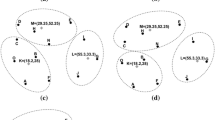Abstract
In wireless sensor networks (WSNs), the clustering architecture balances the energy consumption of the sensor nodes as compared with the flat network architecture. The cluster heads which are nearer to the sink node spend more energy than other cluster heads since it relays the packets in addition to its essential functions. The mobile sinks avoid such an energy hole scenario in sensor networks. Several schemes address the mobility of sink to balance the energy consumption of sensor nodes in the last few years. Those schemes give their attention to either sink path determination or sojourn location determination calculations. Therefore an Energy Efficient Optimal Sojourn Location of Mobile Sink (E2OSLMS) scheme is proposed in this paper to determine the optimal sojourn location of the mobile sink in an energy-efficient manner. In this proposed scheme, the mobile sink moves on a spiral path among clusters and stays in each cluster for a limited time. The sojourn locations are optimized using a fuzzy rule base in each cluster upon the arrival of the mobile sink. The simulation results outperform the proposed scheme as compared with the other two related schemes in terms of energy consumption of nodes and lifetime of the network.










Similar content being viewed by others
References
Touati Y, Daachi B, Arab AC (2017) Energy management in wireless sensor networks, ISTE Press and Elsevier Ltd
Engmann F, Katsriku FA, Abdulai J, Adu-Manu KS, Banaseka FK (2018) Prolonging the lifetime of wireless sensor networks: A review of current techniques. Wirel Commun Mob Comput
Nayak P, Vathasavai B (2017) Energy Efficient Clustering Algorithm for Multi-Hop Wireless Sensor Network Using Type-2 Fuzzy Logic. IEEE Sens J 17(14):4492–4499
Agrawal A, Singh V, Jain S, Gupta RK (2018) GCRP: Grid-cycle routing protocol for wireless sensor network with mobile sink. AEU Int J Electron Commun 94:1–11
Asharioun H, Asadollahi H, Wan T, Gharaei N (2015) A Survey on Analytical Modeling and Mitigation Techniques for the Energy Hole Problem in Corona-Based Wireless Sensor Network. Wireless Pers Commun 81:161–187
Ma M, Yang Y (2007) An energy-efficient data gathering mechanism for large-scale multihop sensor networks. IEEE Transactions on Parallel Distributed Systems 18(10):1476–1488
Wang J, Yin Y, Zhang J, Lee S, Sherratt RS (2013) Mobility based energy efficient and multi-sink algorithms for consumer home networks. IEEE Trans Consum Electron 59(1):77–84
Wang J, Zuo L, Shen J, Li B, Lee S (2015) Multiple mobile sink based routing algorithm for data dissemination in wireless sensor networks. Concurrency and Computation: Practice and Experience 27(10):2656–2667
Gu Y, Ji Y, Li J, Zhao B (2013) ESWC: efficient scheduling for the mobile sink in wireless sensor networks with delay constraint. IEEE Trans Parallel Distrib Syst 24(7):1310–1320
Alia OM, Al-Ajouri A (2017) Maximizing wireless sensor network coverage with minimum cost using harmony search algorithm. IEEE Sens J 17(3):882–896
Gharaei N, Malebary SJ, Bakar KA, Hashim SZH, Butt SA, Sahar DG (2019) Energy-efficient mobile-sink sojourn location optimization scheme for consumer home networks. IEEE Access 7: 112079–112086
Guo J (2012) Sink mobility schemes in wireless sensor networks for network lifetime extension. Electronic Theses and Dissertations
Akkaya K, Younis M, Bangad M (2009) Sink repositioning for enhanced performance in wireless sensor networks. Comput Netw 49(4), 512–534.
Akbar M, Javaid N, Abdul, W, Ghouzali S, Khan A, Niaz IA, Ilahi M (2017) Balanced transmissions based trajectories of mobile sink in homogeneous wireless sensor networks. Journal of Sensors
Wang J, Cao J, Sherratt RS, Park JH (2018) An improved ant colony optimization-based approach with mobile sink for wireless sensor networks. Journal of Supercomputing 74:6633–6645
Khodashahi MH, Tashtarian F, Moghaddam MHY, Honary MT (2010) Optimal location for mobile sink in wireless sensor networks. IEEE Wireless Communications and Networking Conference, Sydney, NSW, Australia
Ferng H, Hadiputro M, Kurniawan A (2011) Design of Novel Node Distribution Strategies in Corona-Based Wireless Sensor Networks. IEEE Trans Mob Comput 10(9):1297–1311
Wang J, Cao J, Ji S, Park DJH (2017) Energy-efficient cluster-based dynamic routes adjustment approach for wireless sensor networks with mobile sinks. Journal of Supercomputing 73(7):3277–3290
Lin K, Chen M (2012) Energy equilibrium based on corona structure for wireless sensor networks. Wirel Commun Mob Comput 12(13):1203–1214
Zhou Z, Du C, Shu L, Hancke G, Niu J, Ning H (2016) An Energy-Balanced Heuristic for MobileSink Scheduling in Hybrid WSNs. IEEE Trans Industr Inf 12(1):28–40
Liang W, Luo J (2011) Network lifetime maximization in sensor networks with multiple mobile sinks. IEEE 36th Conference on Local Computer Networks, Bonn, Germany, 350–357
Liang W, Luo J, Xu X (2010) Prolonging network lifetime via a controlled mobile sink in wireless sensor networks. IEEE Global Telecommunications Conference, Miami, FL, 1–6
Lu Y, Sun N, Pan X (2018) Mobile Sink-Based Path Optimization Strategy in Wireless Sensor Networks Using Artificial Bee Colony Algorithm. IEEE Access 7:11668–11678
Gharaei N, Bakar KA, Hashim SZM, Pourasl AH, Butt SA (2018) Collaborative Mobile Sink Sojourn Time Optimization Scheme for Cluster-Based Wireless Sensor Networks. IEEE Sens J 18(16):6669–6676
Yourong C, Zhangquan W, Ren T, Liu Y, Lv H (2014) Maximizing lifetime of wireless sensor networks with mobile sink nodes. Math Probl Eng
Marta M, Cardei M (2008) Using sink mobility to increase wireless sensor networks lifetime. International Symposium on a World of Wireless, Mobile and Multimedia Networks, Newport Beach, CA, USA
Kaswan A, Nitesh K, Jana PK (2017) Energy efficient path selection for mobile sink and data gathering in wireless sensor networks. AEU Int J Electron Commun 73:110–118
Ahmad A, Javaid N, Ahmed SH, Bouk SH, Ilahi M, Kim D (2015) COME: cost optimization with multi-chaining for energy efficient communication in wireless sensor networks. Int J Ad Hoc Ubiquitous Comput 20(3):186–198
Mehto A, Tapaswi S, Pattanaik KK (2020) Virtual grid-based rendezvous point and sojourn location selection for energy and delay efficient data acquisition in wireless sensor networks with mobile sink. Wireless Netw 26:3763–3779
Sha C, Song D, Yang R, Gao H, Huang H (2019) A Type of Energy-balanced Tree based Data Collection Strategy for Sensor Network with Mobile Sink. IEEE Access 7:85226–85240
Shi J, Wei X, Zhu W (2016) An efficient algorithm for energy management in wireless sensor networks via employing multiple mobile sinks. Int J Distrib Sens Netw 12(1):3179587
Koc M, Korpeoglu I (2015) Coordinated movement of multiple mobile sinks in a wireless sensor network for improved lifetime. J Wirel Commun Netw
Gharaei N, Bakar KA, Hashim SZH, Pourasl AH (2018) Inter- and Intra-Cluster Movement of Mobile Sink Algorithms for Cluster-based Networks to Enhance the Network Lifetime. AdHoc Networks 85:60–70
Author information
Authors and Affiliations
Corresponding author
Additional information
Publisher's Note
Springer Nature remains neutral with regard to jurisdictional claims in published maps and institutional affiliations.
Rights and permissions
About this article
Cite this article
K, M. Determination of energy efficient optimal sojourn location of mobile sinks in clustered corona-based wireless sensor networks. Peer-to-Peer Netw. Appl. 15, 1–12 (2022). https://doi.org/10.1007/s12083-021-01224-0
Received:
Accepted:
Published:
Issue Date:
DOI: https://doi.org/10.1007/s12083-021-01224-0




